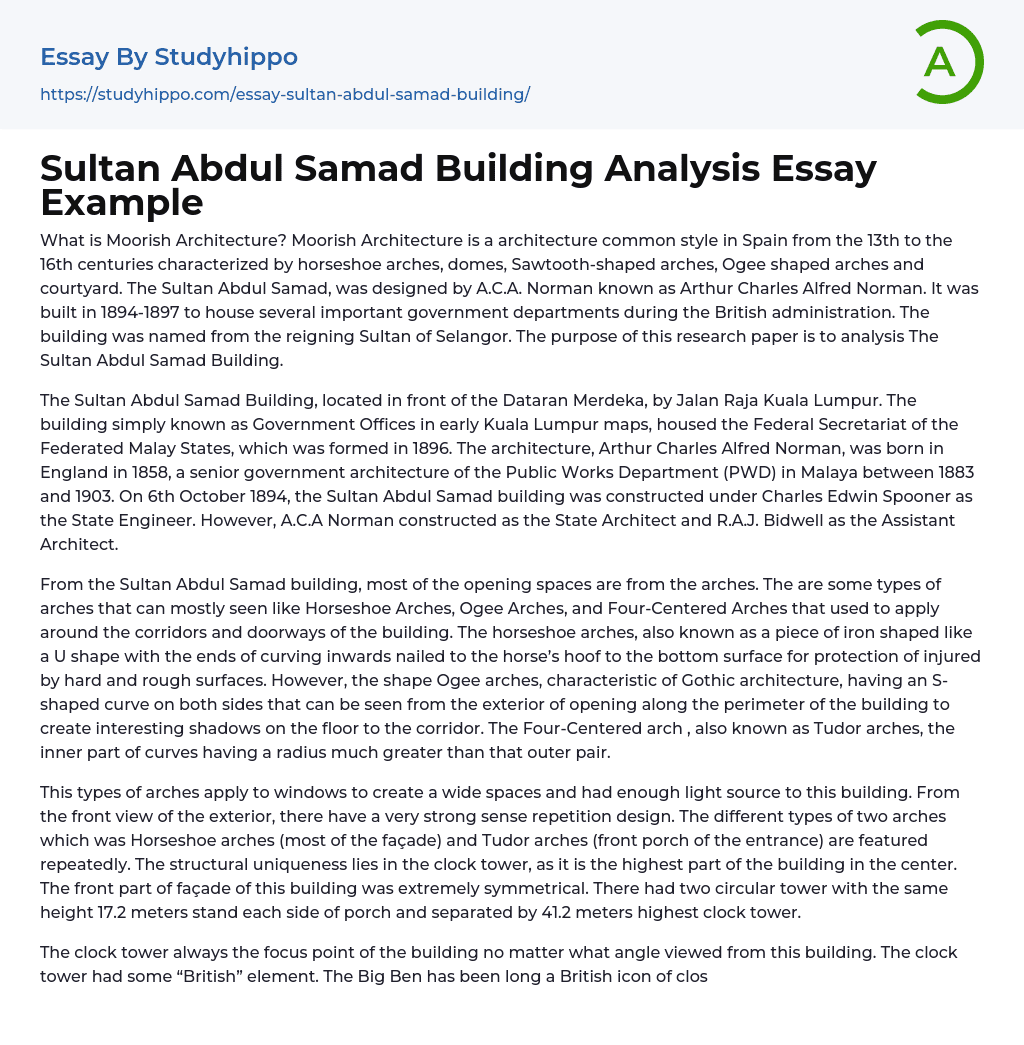What is Moorish Architecture? Moorish Architecture is a architecture common style in Spain from the 13th to the 16th centuries characterized by horseshoe arches, domes, Sawtooth-shaped arches, Ogee shaped arches and courtyard. The Sultan Abdul Samad, was designed by A.C.A. Norman known as Arthur Charles Alfred Norman. It was built in 1894-1897 to house several important government departments during the British administration. The building was named from the reigning Sultan of Selangor. The purpose of this research paper is to analysis The Sultan Abdul Samad Building.
The Sultan Abdul Samad Building, located in front of the Dataran Merdeka, by Jalan Raja Kuala Lumpur. The building simply known as Government Offices in early Kuala Lumpur maps, housed the Federal Secretariat of the Federated Malay States, which was formed i
...n 1896. The architecture, Arthur Charles Alfred Norman, was born in England in 1858, a senior government architecture of the Public Works Department (PWD) in Malaya between 1883 and 1903. On 6th October 1894, the Sultan Abdul Samad building was constructed under Charles Edwin Spooner as the State Engineer. However, A.C.A Norman constructed as the State Architect and R.A.J. Bidwell as the Assistant Architect.
From the Sultan Abdul Samad building, most of the opening spaces are from the arches. The are some types of arches that can mostly seen like Horseshoe Arches, Ogee Arches, and Four-Centered Arches that used to apply around the corridors and doorways of the building. The horseshoe arches, also known as a piece of iron shaped like a U shape with the ends of curving inwards nailed to the horse’s hoof to the bottom surface for protection of injured b
hard and rough surfaces. However, the shape Ogee arches, characteristic of Gothic architecture, having an S-shaped curve on both sides that can be seen from the exterior of opening along the perimeter of the building to create interesting shadows on the floor to the corridor. The Four-Centered arch , also known as Tudor arches, the inner part of curves having a radius much greater than that outer pair.
This types of arches apply to windows to create a wide spaces and had enough light source to this building. From the front view of the exterior, there have a very strong sense repetition design. The different types of two arches which was Horseshoe arches (most of the façade) and Tudor arches (front porch of the entrance) are featured repeatedly. The structural uniqueness lies in the clock tower, as it is the highest part of the building in the center. The front part of façade of this building was extremely symmetrical. There had two circular tower with the same height 17.2 meters stand each side of porch and separated by 41.2 meters highest clock tower.
The clock tower always the focus point of the building no matter what angle viewed from this building. The clock tower had some “British” element. The Big Ben has been long a British icon of closed minds. Sultan Abdul Samad Building, another significant feature is three of the prominent towers. The copper dome based on the India - Saracen architecture style. The bright red brick stand out the paleness of gray lime. Result in contrast has caused locals Sultan Abdul Samad Building nicknamed the "blood and bandages of the building.
style="text-align: justify">The function of Sultan Abdul Samad building was home to the House of Parliament which at one point housed the High Court of Malaya. It was the center of administrative office at that time. And it also serves as the backdrop for important events such as the National Day Parede on August 31.
The Sultan Abdul Samad building has witnessed to many important historical events of our country. It’s aren’t just a historical building or an expensive structure, it’s represent an identity and state for our country. It looked up us standing proud gained independence, at a set time, which marks the peninsula, between Singapore and the East Coast to join more than a century. Importantly, like this colonial architecture are preserved, not only as a country historical buildings, but also as a reminder of the difficulties, let us remember our ancestors experienced.


Unfortunately copying the content is not possible
Tell us your email address and we’ll send this sample there.
By continuing, you agree to our Terms and Conditions.


